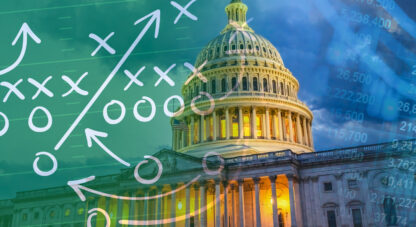Weekly Hard Asset Insights
By David McAlvany
Crossing the Inflation Rubicon
Major US stock market indexes are now firmly back in melt-up mode. The S&P 500 closed the week at new all-time highs, and the latest record high was the 4th new all-time high reached just this week alone. In fact, the October S&P party brings the total number of new all-time highs notched in 2021 to nearly 60. The strong close to the month also solidifies this October as the best month so far in 2021 for the S&P 500. This fearless momentum-market rocket has just left the launch pad again, heading for the uncharted stratosphere where the sky and the unbounded imaginations of bulls are the only limits.
Now, despite the great, and I do mean great, many significant questions over the health of this surging market and its outlook ahead, the ongoing major index rally off the Covid pandemic lows has certainly been impressive. The rally is made all the more spectacular when considering how improbable it seemed in the dark days of max Covid doom in March 2020. Among all the major Wall Street banks, the highest S&P 500 year-end price target for 2020 was 3,600. Again, that was the most bullish of the bullish 2020 year-end price targets, and yet the S&P closed the year at 3,756. So far in 2021 the script is identical. With two months still remaining in the year, the S&P 500 has already left last summer’s crop of 2021 year-end price targets from the 16 largest Wall Street banks firmly in the dust. The year-end S&P price targets from the 16 banks last summer are evenly distributed between a range of 3,800 – 4,400. On the last Friday of October, the S&P closed at 4,605! Pretty remarkable! It seems reasonable to think that a chapter in a future finance book might cite booming market prices that outpace every single major Wall-Street price target for two straight years as a signal confirming the existence of a bubble.
While the stock market surges, the US Commerce Department on Thursday reported a significant slowdown in US economic growth. Q3 gross domestic product (GDP) came in at 2%. The reading is notably lower than the 2.8% that economists surveyed by Dow Jones had been expecting, and growth was significantly reduced from the Q2 final revised GDP growth of 6.7%.
The report revealed that net exports were a drag on GDP once again as the trade deficit widened to record levels. Exports withered and imports increased, subtracting 1.1% from GDP. It’s not surprising that imports would grow as businesses scramble for product in this era of scarce goods and shortages, but it is interesting that the report also showed, after contracting in recent quarters, a surprisingly strong increase in inventories that added 2.07% to GDP. Without the contribution of this surprisingly strong inventory data, GDP would have actually contracted. The inventory data will be an important item to watch in future revisions. If inventories were overstated, then Q3 GDP may end up being revised lower. If the inventory data is correct, then perhaps the data suggests that we are passing peak goods shortages. While that would be a very positive development, numerous other sources, including a recent Wall Street Journal article, suggest the supply problems remain and may even be deepening. The GDP number reveals that the US economy grew at its slowest pace since the pandemic recovery began.
This week we also had the release of last month’s personal consumption expenditure (PCE) data. PCE is the Fed’s favorite inflation gauge, and the September data revealed that inflation is at a 30-year high. The September PCE deflator increased by 4.4% year-over-year, the highest rate of inflation since 1991, registering an increase over August’s 4.2% YoY pace. Despite the persistent hot inflation, Treasury Secretary Janet Yellen seems to have shifted toward a new version of “transitory” inflation that can be best described as a new narrative of extremely long and drawn-out transitory inflation. Yellen said this week that, “On a 12-month basis, the inflation rate will remain high into next year because of what’s already happened, but I expect improvement by the middle to the end of next year—second half of next year….”
Yellen’s argument seems to reflect the view discussed in previous HAI’s that the hot inflation surge is the result of contributions to increased prices from inflation components that will quickly fade. This is the distinction between items within the overall inflation readings that are of the transitory variety rather than other items which tend to be persistent. Well, unfortunately for Yellen, members of the Fed, and all consumers, this week Bank of America demonstrated that the transitory inflation narrative is collapsing. BofA tracks inflation in a breakdown of the two categories of transitory items and persistent items. The bank scores both categories on a scale from -100, representing extreme deflation, to +100, representing extreme inflation. Back in May, BofA’s transitory basket was scoring a +100, while the persistent items were reading at +37. In the most recent readings, however, the transitory items were still at +100, while the persistent items basket has surged to +96. The data series dates back as far as 1995, and never in that time have both the transitory and persistent baskets ever been at all time highs at the same time, as is currently the case.
This is not just an inconvenience. The Harvard School of Public Health released an October report on household experiences in America. Data collected between August and September indicate some troubling findings on household finances. The report sates that, “In the past few months alone, 38% of US households report facing serious financial problems.” The report shows that households with annual incomes under $50,000 report serious financial problems at a whopping 59% rate. The same serious financial problems are reported by 18% of households above $50,000. The report goes on to state that these concerning findings are cited “despite 67% of households reporting that in the past few months they have received financial assistance from the government.” The report also reveals that 32% of households say they are in a worse financial situation now than before the Covid outbreak, while only 19% say they are in a better situation. The report also indicates that 19% of all households and 30% in the under $50,000 category lost all of their savings since the Covid outbreak and “have no savings to fall back on.” These findings coincide and seem to corroborate a broad swath of recent surveys that show consumer confidence and sentiment have plummeted in recent months.
A look at numerous indications from just this week suggest serious financial problems may be more likely to increase going forward than to fade. Reports indicate that the recent eruption of an energy crisis and rising fuel costs will likely have numerous knock-on effects. Companies now dealing with another avenue of cost escalations via accelerating energy cost inflation are expected to increasingly pass on higher costs to the consumer. The situation is not expected to be improved by large OPEC+ oil production increases, as consensus is for OPEC+ to remain tight on production at their next meeting in November.
Meanwhile, according to a Reuters survey, after cutting prices for two straight months, state oil giant Saudi Aramco may now increase the selling price for their flagship product. Also not helpful to the outlook for energy prices is that, according to the US Energy Information Administration, coal supplies have now plunged at US power plants to their lowest levels since 1997. About a quarter of all US power generation is derived from coal. With supplies so low, prices are likely to rise further.
A particularly noteworthy knock-on effect of higher energy costs is food price inflation. In the wake of globalization, most global food consumption no longer comes from local farms, but rather from large commercial operations that transport their products all over the globe. In an interview with Bloomberg, senior economist at the UN’s Food and Agriculture Organization Abdolreza Abbassian said, in reference to food price inflation, “It’s this combination of things that’s beginning to get very worrying…. It’s not just the isolated food-price numbers, but all of them together. I don’t think anyone two or three months ago was expecting the energy prices to get this strong.” The fertilizer industry is also heavily affected by oil and fuel prices, and increasing fertilizer costs will be another contributor to food price inflation that, according to a recent report, is already at decade-high levels.
Households with “serious financial problems” are also getting no relief from the housing market. According to the latest national Case-Shiller index, home prices were up 19.8% YoY in August. That is the biggest increase on record. According to a new release by the St. Louis Federal Reserve, median US home prices just passed $400,000 to the highest level ever. That is a 13% increase over the same period last year.
Also out this week was the final October University of Michigan Survey of Consumers. Neither the results nor the comments from survey chief economist Richard Curtin did anything to alleviate concerns over inflation, the economic outlook, or consumer stress. In an alarming assessment, Curtin said that consumer confidence remained “virtually unchanged” at pandemic low levels despite the positive effects of receding Covid concerns and expectations for higher levels of income. Curtin suggests that these drivers of optimism are being offset by higher rates of inflation and falling confidence in government economic policies. This is key. Lousy consumer confidence is not about Covid, as many are quick to claim. In a non-inflationary environment, receding Covid concerns along with expectations for increases in income would translate to tremendous enthusiasm. In an inflationary environment, where concerns over government economic policies indicate concerns over escalating inflation, the poor sentiment likely reflects a recognition that expected increases in wages will be outstripped by even higher cost of living increases.
Consumers as of the October survey are “not only anticipating the highest year-ahead inflation rate since 2008…, consumers also expressed greater uncertainty about the year-ahead inflation rate than anytime in nearly 40 years.” Curtin also notes that this was the first major spike in inflation uncertainty recorded outside of a recession. “Even uncertainty about the long-term inflation rate was the highest in more than a decade. In keeping with the results of the above-mentioned Harvard survey, Curtin said that one in every five households “spontaneously” mentioned declining living standards due to inflation. Curtin goes on to state:
The patterns of consumers’ reactions to recent rises in inflation represent the preconditions that can promote an escalating inflation rate during the year ahead. Consumers’ recognition of high and rising prices is near universal…. The acceptance of higher prices was caused by swollen savings due to the record pandemic cash incentives as well as by… new social support programs. The declining resistance to price hikes among buyers will be joined by less resistance among sellers to hiking prices that will be justified by higher materials and labor costs. These reactions promote an accelerating inflation rate until a tipping point is reached when consumers’ incomes can no longer keep pace with escalating inflation. In the past inflationary era, one recession was insufficient to realign (inflation) expectations; it required a series of boom-bust cycles, until the Fed’s Volcker finally defeated inflation by raising interest rates to record levels.
For Curtin, this is a major new shift in tone, direction, and conviction toward where we are headed with inflation. The survey chief economist is now officially ringing the alarm bell. For many months, the key to the degree of the inflation impact has resided in the potential for a broad-based crisis of confidence in government economic policy, the collapse in credibility given to the “transitory” narrative, and in a rise of inflation expectations initiating a popular shift into a widespread inflation psychology. Furthermore, the noted expectations for higher incomes in the survey offer a final key hint pointing towards an inflationary future. The higher income expectations come amid an environment where the bargaining power of labor is dramatically increasing for the first time in decades. Survey respondents expect higher incomes, and, under present circumstances, they will likely get just that, and in the process initiate a classic inflation accelerating wage-price spiral. In Friday’s survey, Curtin is suggesting that we are dangerously close to crossing, if we haven’t already crossed, the inflation Rubicon. What seems abundantly clear is that Fed policy is lagging events, and we are now dealing with the consequences.
While Curtin makes mention of Paul Volcker defeating inflation by implementing record high interest rates in the early 1980s, that was then, and this is now. The early ’80s stock market valuations were very cheap, limiting the potential for catastrophic downside risks to markets that could have, in concert with stiflingly high Volcker interest rates, devastated the economy. In our present moment of extreme high valuations, a double whammy of the crippling effects of interest rates high enough to eradicate inflation along with the resulting stock market collapse that would likely be triggered would almost certainly mortally wound the economy. Even more important, the US government debt-to-GDP ratio was just a bit above 30% when Volcker jacked interest rates. Now debt-to-GDP is far north of 100%. Our present day’s rampant overleverage throughout the economy means that a devastating sensitivity now exists to significantly higher rates in all aspects of the economy, from consumer to corporate to sovereign levels. In other words, the Volcker medicine needed to cure a legitimate inflation spiral may not be available this go-around. All eyes now turn to next Week’s FOMC meeting.
As for weekly performance: The S&P 500 closed the week up 1.33%. Gold was lower by 0.69%, while silver dropped by 2.04% on the week. Platinum was off by 2.98%, and palladium was lower by 2.72%. The HUI gold miners index dropped 4.18%. The IFRA iShares US Infrastructure ETF was nearly flat, down 0.06% for the week. Energy commodities were slightly lower, but extremely volatile. WTI crude oil lost 0.23%. Natural gas was down 0.62% on the week. The CRB Commodity Index was up 0.46%, while copper dropped by 2.89%. The Dow Jones US Real Estate Index ended the week down 0.20%, while the Dow Jones Utility Average Index was down 0.60%. The US Dollar Index was higher this week by 0.53% to close the week at 94.12. The yield on the 10-year Treasury lost 11 bps to close the week at 1.55%.
Have a great weekend!
Best Regards,
David McAlvany
Chief Executive Officer
MWM LLC















